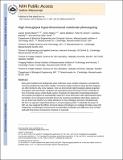High-throughput hyperdimensional vertebrate phenotyping
Author(s)
Pardo-Martin, Carlos; Allalou, Amin Mohamed; Medina, Jaime; Eimon, Peter; Wählby, Carolina; Yanik, Mehmet Fatih; ... Show more Show less
DownloadYanik_High-throughput.pdf (2.906Mb)
PUBLISHER_POLICY
Publisher Policy
Article is made available in accordance with the publisher's policy and may be subject to US copyright law. Please refer to the publisher's site for terms of use.
Terms of use
Metadata
Show full item recordAbstract
Most gene mutations and biologically active molecules cause complex responses in animals that cannot be predicted by cell culture models. Yet animal studies remain too slow and their analyses are often limited to only a few readouts. Here we demonstrate high-throughput optical projection tomography with micrometre resolution and hyperdimensional screening of entire vertebrates in tens of seconds using a simple fluidic system. Hundreds of independent morphological features and complex phenotypes are automatically captured in three dimensions with unprecedented speed and detail in semitransparent zebrafish larvae. By clustering quantitative phenotypic signatures, we can detect and classify even subtle alterations in many biological processes simultaneously. We term our approach hyperdimensional in vivo phenotyping. To illustrate the power of hyperdimensional in vivo phenotyping, we have analysed the effects of several classes of teratogens on cartilage formation using 200 independent morphological measurements, and identified similarities and differences that correlate well with their known mechanisms of actions in mammals.
Date issued
2013-02Department
Harvard University--MIT Division of Health Sciences and Technology; Massachusetts Institute of Technology. Department of Biological Engineering; Massachusetts Institute of Technology. Department of Electrical Engineering and Computer Science; Massachusetts Institute of Technology. Research Laboratory of ElectronicsJournal
Nature Communications
Publisher
Nature Publishing Group
Citation
Pardo-Martin, Carlos, Amin Allalou, Jaime Medina, Peter M. Eimon, Carolina Wählby, and Mehmet Fatih Yanik. “High-Throughput Hyperdimensional Vertebrate Phenotyping.” Nature Communications 4 (February 12, 2013): 1467.
Version: Author's final manuscript
ISSN
2041-1723